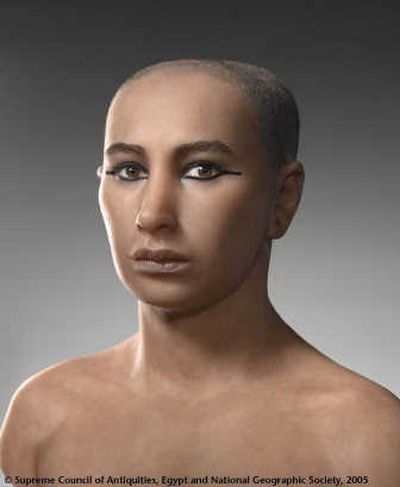King Tut’s face unveiled

LUXOR, Egypt – King Tut’s buck-toothed face was unveiled Sunday for the first time in public – more than 3,000 years after the youngest and most famous pharaoh to rule ancient Egypt was shrouded in linen and buried in his golden underground tomb.
Archaeologists carefully lifted the fragile mummy out of a quartz sarcophagus decorated with stone-carved protective goddesses, momentarily pulling aside a beige covering to reveal a leathery black body.
The linen was then replaced over Tut’s narrow body so only his face and tiny feet were exposed, and the 19-year-old king, whose life and death has captivated people for nearly a century, was moved to a simple glass climate-controlled case to keep it from turning to dust.
“I can say for the first time that the mummy is safe and the mummy is well-preserved, and at the same time, all the tourists who will enter this tomb will be able to see the face of Tutankhamun for the first time,” Egypt’s antiquities chief Zahi Hawass said from inside the hot, sticky tomb.
Hawass said scientists began restoring the badly damaged mummy more than two years ago.
Much of the body is broken into 18 pieces – damage sustained when British archaeologist Howard Carter first discovered it 85 years ago, took it from its tomb and tried to pull off the famous golden mask, Hawass said.
But experts fear a more recent phenomenon – mass tourism – is further deteriorating Tut’s mummy.
Thousands of tourists visit the underground chamber every month, and Hawass said within 50 years the mummy could dissolve into dust.
“The humidity and heat caused by … people entering the tomb and their breathing will change the mummy to a powder. The only good thing (left) in this mummy is the face. We need to preserve the face,” said Hawass.
In 2005, scientists removed Tut’s mummy from his tomb and placed it into a portable CT scanner for 15 minutes to obtain a three-dimensional image. The scans were the first done on an Egyptian mummy.
The results ruled out that Tut was violently murdered – but stopped short of definitively concluding how he died around 1323 B.C.
The CT scan also provided the most revealing insight yet into Tut’s life. He was well-fed and healthy, but slight, standing 5 feet 6 inches tall at the time of his death. The scan also showed he had the overbite characteristic of other kings from his family, large incisor teeth and his lower teeth were slightly misaligned.